Currently 27 cultural and natural sites in india have been designated Unesco World Heritage Sites. In the second of a three-article series, Srinidhi Raghavendra overviews Unesco World Heritage Sites of central, eastern and north-eastern India
In 1965, the United States of America called for creation of a World Heritage Trust which would promote international cooperation to protect “the world’s superb natural and scenic areas and historic sites for the present and the future of the entire world citizenry”. The idea was accepted by nature preservation organisations and in 1968 the International Union for Conservation of Nature drafted similar proposals which were presented at the United Nations Conference on Human Environment in Stockholm in 1972. The UN General Assembly referred the idea to the United Nations Educational, Scientific and Cultural Organisation (Unesco) and that very year Unesco drafted an international treaty under the name and style of Convention Concerning Protection of the World Cultural and Natural Heritage. The prime objective of the treaty is to promote the identification, protection and preservation of cultural and natural heritage sites around the world, believed to be of outstanding value to humanity
Currently there are 851 sites (660 cultural, 166 natural, and 25 mixed properties) spread across 141 countries worldwide on the World Heritage list, with Italy leading the scroll (41).
Widely acknowledged as one of the oldest civilisations of the world, India has a rich cultural and natural heritage. Unfortunately due to centuries of neglect, many of these sites have fallen into ruin and require extensive restoration work before they can be included in the World Heritage list. Currently only 27 (22 cultural and five natural) sites in India have qualified for the standards of the UN World Heritage Convention. Applications for including an additional 19 sites are pending with the Unesco World Heritage Committee.
Last month (July), nine of the 27 World Heritage Sites of north India were identified and highlighted on these pages. In this issue we feature eight Unesco World Heritage Sites located in the central, eastern and north-eastern regions of India. The sites include: Khajuraho Group of Monuments, Rock Shelters of Bhimbetka and Buddhist Monuments at Sanchi, Madhya Pradesh; Mountain Railways of India, West Bengal and Tamil Nadu; Sundarbans National Park, West Bengal; Kaziranga National Park and Manas Wildlife Sanctuary, Assam and the world-famous Konark Sun Temple of Orissa.
Buddhist monuments of Sanchi
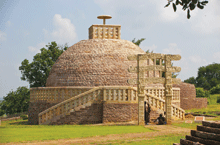 This oldest Buddhist sanctuary in the world dates back to 300 BC. Sited in Sanchi (pop. 6,785), a mere 40 km from Bhopal (Madhya Pradesh), it was accorded World Heritage Site status in 1989. An eclectic collection of intricately carved monolithic pillars, exquisite palaces, temples and monas-teries in various states of conservation, they are an eloquent tribute to the aesthetic prowess of medieval sculptors. Documented history affirms this is the oldest Buddhist sanctuary which was a major centre of Buddhism until the 12th century AD. The piece de resistance of the Sanchi monuments is the Great Stupa, which was originally commissioned by Emperor Ashoka in the third century BC. The original monument was a simple hemispheric brick structure crowned by a chatra, a parasol-like structure constructed to shelter the relics of the Buddha.
This oldest Buddhist sanctuary in the world dates back to 300 BC. Sited in Sanchi (pop. 6,785), a mere 40 km from Bhopal (Madhya Pradesh), it was accorded World Heritage Site status in 1989. An eclectic collection of intricately carved monolithic pillars, exquisite palaces, temples and monas-teries in various states of conservation, they are an eloquent tribute to the aesthetic prowess of medieval sculptors. Documented history affirms this is the oldest Buddhist sanctuary which was a major centre of Buddhism until the 12th century AD. The piece de resistance of the Sanchi monuments is the Great Stupa, which was originally commissioned by Emperor Ashoka in the third century BC. The original monument was a simple hemispheric brick structure crowned by a chatra, a parasol-like structure constructed to shelter the relics of the Buddha.
A century later during the reign of Pusyamitra Sunga the stupa was vandalised, but restored by later Sunga kings, who expanded it to almost twice its original size. During the Sunga era, the dome of the stupa was flattened at the top and crowned by three superimposed parasols within a square railing. This flat-topped dome became symbolic of the wheel of law.
Following the decline of the Sunga dynasty, the Satavahanas rose to power in Sanchi and they added their own touches to the already expanded stupa. The Satavahana kings commissioned construction of the massive gateways and balustrade. The impressive gateways are embossed with sculptures which narrate stories from the life of the Buddha. Additions of stupas, temples, monasteries and other religious structures continued upto the 12th century. But with the decline of Buddhism and following the Muslim invasions and rule from the 13th-18th centuries, the monuments fell into neglect and were forgotten until 1818 when a British military officer and amateur historian, General Taylor accidentally stumbled upon them. Following this extraordinary discovery, several British archaeologists and treasure hunters ravaged the site until 1881, when restoration work was initiated.
Khajuraho group of monuments
In the rural heart of the central Indian state of Madhya Pradesh (pop. 60.3 million) is the village of Khajuraho — famous on the world map for its legendary 10th century temples. Once upon a time the capital city of the Chandela dynasty which reached its apogee between 950 and 1050 AD, Khajuraho’s magnificent temples dedicated to Shiva, Vishnu and Jain Tirthankaras were built by Chandela kings who claimed descent from the Moon god. However, of the 85 temples, only 22 are extant, the rest sadly vandalised by Muslim invaders, British adventurers and other treasure hunters. Nevertheless these restored temples symbolise the cultural glory of medieval Indian art and architecture. Khajuraho (383 km from Bhopal) was declared a World Heritage Site in 1986.
The 22 surviving and substantially restored temples of Khajuraho enshrine Hindu and Jain deities, striking a near-perfect balance between architecture, sculpture and placement. The most popular Kandariya temple, embellished with exuberant carvings and decorative motifs in stone, is ranked among the masterpieces of Indian medieval art.
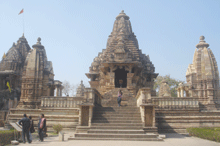 During the past six decades of post-independence India, Khajuraho has transformed into one of the most popular tourist destinations in India attracting over 250,000 domestic and 95,000 international tourists annually. Set amidst a parkland landscape, Khajuraho in its restored form has the character of a nature preserve with manicured lawns, rose beds and ornamental trees. Yet its global renown is attributable to the erotic sculptures adorning the walls, and the numerous frescoes and pillars of the temples of Khajuraho (derived from the Hindi word khajur meaning date palm).
During the past six decades of post-independence India, Khajuraho has transformed into one of the most popular tourist destinations in India attracting over 250,000 domestic and 95,000 international tourists annually. Set amidst a parkland landscape, Khajuraho in its restored form has the character of a nature preserve with manicured lawns, rose beds and ornamental trees. Yet its global renown is attributable to the erotic sculptures adorning the walls, and the numerous frescoes and pillars of the temples of Khajuraho (derived from the Hindi word khajur meaning date palm).
The spiral superstructures of the Khajuraho temples follow the northern Indian shikhara style of architecture featuring the panchayatana layout which is characterised by a main shrine and subordinate shrines in four corners. The Kandariya Mahadeva temples are the most striking of the western group which comprise 84 shikharas with the main one rising to a height of 116 ft.
Contrary to popular perception, the interior walls of the Khajuraho temples are bereft of erotic art forms which are depicted only on exterior walls. Some of the temples have double layered walls featuring miniature erotic carvings only on the outer portion of the inner walls. Yet the great majority of the external carvings and stone adornments project human forms with perhaps only 10 percent depicting sexual themes. The rest portray the everyday life of the times, with musicians, potters, farmers, and other common people being ubiquitous.
There are numerous explanations about the erotic carvings embossed upon the exterior walls. A plausible one is an injunction to devotees to leave sexual desire outside the temple premises, because temples are divine sanctums and should not be affected by the physical and the worldly.
Rock shelters of Bhimbetka
Located in the foothills of the Vindhya Mountain range in the heart of the Deccan Plateau, the Rock Shelters of Bhimbetka are a recent (2003) addition to the World Heritage Site list. Discovered in 1888 in the Raisen district of Madhya Pradesh (45 km from Bhopal), the Bhimbetka shelters exhibit the earliest traces of human life in the subcontinent and its rock paintings are estimated to be over 9,000 years old. Five groups of natural rock shelters were discovered underneath massive sandstone outcrops. Within the shelters are paintings that shed light on a little-known period in history — the Mesolithic Age (20,000-18,000 BC).
Bhimbetka derives its name from the locale’s association with the mythological Bhima, one of the main characters of the epic Mahabharata. The area surrounding the rock shelters is covered by thick vegetation, has abundant natural resources in terms of perennial water supply and rich diversity of flora and fauna, and bears a significant resemblance to rock art sites of the Kakadu National Park, Australia, cave paintings of the Kalahari Desert, and the Lascaux caves in France.
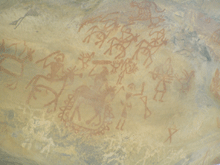 Since the original discovery in 1888, more than 700 such shelters have been identified, of which 243 are in the Bhimbetka group and 178 in the Lakha Juar group. Archeological studies have revealed a continuous sequence of Stone Age cultures (from the late Acheulian to late Mesolithic), depicted on the world’s oldest stone walls and floors.
Since the original discovery in 1888, more than 700 such shelters have been identified, of which 243 are in the Bhimbetka group and 178 in the Lakha Juar group. Archeological studies have revealed a continuous sequence of Stone Age cultures (from the late Acheulian to late Mesolithic), depicted on the world’s oldest stone walls and floors.
The cave paintings still exhibit a rich hue of red and white paints with occasional use of green and yellow and are an invaluable record of workaday events of different ages such as hunting, dancing, music, horse and elephant riders, honey collection, makeup and decoration of bodies, and household scenes. Animals such as bison, tigers, lions, wild boar, elephants, antelope, lizards, crocodiles etc are also abundantly depicted and interspersed with religious symbols and motifs.
The superimposition of paintings above existing impressions shows that the shelters were inhabited by different people over the ages. Classified into five categories based on their periods: Upper Paleolithic; Mesolithic; Chalcolithic; Early historic and Medieval, they reveal a wealth of knowledge about near-forgotten ages. The most magnificent of the lot are depicted on Zoo Rock, a virtual gallery of elephants, sambar, bison and deer.
The fact that the cave paintings have not faded even after thousands of years continues to amaze scientists and researchers. The paints were an admixture of earth, vegetable dyes, roots and animal fat, while materials derived from fibrous plants were composited into paint brushes.
Mountain railways of India
The mountain railways of India comprise a collection of four distinctly different lines located across the country. The lines include: the Darjeeling Himalayan Railway (inscribed in 1999); the Nilgiri Mountain Railway (inscribed in 2005); the Kalka-Shimla Railway and Matheran Hill Railway (inscribed in 2007). These railway lines were accorded World Heritage status because they are outstanding examples of bold, ingenious engineering solutions which established durable and enduring links through rugged, mountainous terrain.
The Darjeeling Himalayan Railway (DHR) runs on a 2 ft (610 mm) narrow-gauge line from the plains of Siliguri to the Darjeeling hills of West Bengal. The 86 km line laid between 1879-1881 rises from a height of 340 ft (Siliguri) to 7,480 ft (Darjeeling), powered by steam engines. This was the second railway worldwide to be accorded World Heritage status after the Semmering Railway, Austria (1998).
Fondly known as the ‘toy train’, DHR passes through a scenic mountainscape of the Himalayan foothills through Kurseong and Ghoom, where it takes a 360 degree turn known as the Batasia loop. Though it takes well over eight hours to negotiate 86 km, the stunning mountain vistas make the ride eminently worthwhile.
The Nilgiri Mountain Railway (NMR) connects the town of Mettupalayam on the Deccan plain with the hill station of Udagamandalam (Ooty) in the Nilgiri Hills of Tamil Nadu. Flagged off in 1899, NMR trains powered by steam engines continue to haul people and farm produce over a 3.3 ft narrow guage track.
The train negotiates 208 curves, 16 tunnels, and 250 bridges to cover a distance of 46 km. The steady upward journey through the densely wooded Nilgiri hills is exhilarating, as the train chugs uphill for 4 hours and 50 minutes from Mettupalayam to reach Ooty (7,228 ft) via Coonoor (5,616 ft), Wellington (5,804 ft) and Lovedale (7,694 ft).
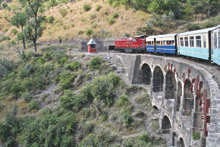 The 2 ft 6 in narrow gauge Kalka-Shimla Railway links the hill stations of Kalka and Shimla in the Himalayan state of Himachal Pradesh. Noted for the breathtaking views of the hills and surrounding villages it offers, within the engineers’ fraternity it is also known for the sharp incline of its 96 km stretch. The construction of this scenic railway line was started in 1898 by the Delhi-Umbala Co at a then astronomical cost of Rs.1.73 crore, and was completed in 1903. Subsequently it was purchased by the British India government in 1906.
The 2 ft 6 in narrow gauge Kalka-Shimla Railway links the hill stations of Kalka and Shimla in the Himalayan state of Himachal Pradesh. Noted for the breathtaking views of the hills and surrounding villages it offers, within the engineers’ fraternity it is also known for the sharp incline of its 96 km stretch. The construction of this scenic railway line was started in 1898 by the Delhi-Umbala Co at a then astronomical cost of Rs.1.73 crore, and was completed in 1903. Subsequently it was purchased by the British India government in 1906.
The train ascends from a height of 2,152 ft at Kalka to 6,811 ft at Shimla negotiating 919 curves, each offering a kaleidoscope of Himalayan sights and sounds as it rumbles through Dharampur, Solan, Kandaghat, Taradevi, Barog, Salogra, Summerhill until it reaches Shimla. En route it also passes through 103 tunnels including the Barog tunnel (3,752 ft) and 864 bridges. Notable among the bridges are No. 493, known as the Arch Gallery.
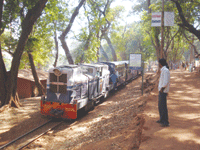 The 20 km Matheran Hill Railway links the town of Neral, 87 km from Mumbai (Maharastra) to the hill station of Matheran. The narrow guage (2 ft) rail track was laid between 1901 and 1907 under the supervision of Abdul Hussein Adamjee Peerbhoy, and financed by his father Sir Adamjee Peerbhoy of the Adamjee Group at a cost of Rs.16 lakh. The unique feature of this railway line is that it runs through large swathes of forest of the Western Ghats connecting holidayers and picknickers from India’s commercial capital with their favourite hill station, where motor cars are banned.
The 20 km Matheran Hill Railway links the town of Neral, 87 km from Mumbai (Maharastra) to the hill station of Matheran. The narrow guage (2 ft) rail track was laid between 1901 and 1907 under the supervision of Abdul Hussein Adamjee Peerbhoy, and financed by his father Sir Adamjee Peerbhoy of the Adamjee Group at a cost of Rs.16 lakh. The unique feature of this railway line is that it runs through large swathes of forest of the Western Ghats connecting holidayers and picknickers from India’s commercial capital with their favourite hill station, where motor cars are banned.
Sun Temple, Konark
The glory of the eastern seaboard state of Orissa (pop. 36 million), the majestic Sun Temple at Konark (65 km from the state capital Bhubaneswar) was inscribed into the list of Unesco World Heritage Sites in 1984. Also known as the Black Pagoda because it is executed in black granite, this 13th century temple was commissioned by King Narasimhadeva I (AD 1236-1264) of the Eastern Ganga Dynasty. The entire temple complex resembles the chariot of Surya, the Sun god drawn by seven spirited horses on twelve pairs of exquisitely wrought wheels. Two imposing lions guard the portals, each crushing a war elephant. The elephant in turn is mounted on a human body.
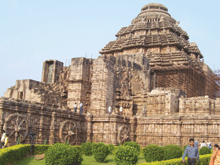 Constructed according to the tenets of the Kalinga School of Architecture, famous as much for its imposing dimensions and faultless proportions as for the harmonious integration of architectural grandeur, the Sun temple’s fine tracery and scrollwork, as well as the natural cut of animal and human figures, give it a marked superiority over other temples.
Constructed according to the tenets of the Kalinga School of Architecture, famous as much for its imposing dimensions and faultless proportions as for the harmonious integration of architectural grandeur, the Sun temple’s fine tracery and scrollwork, as well as the natural cut of animal and human figures, give it a marked superiority over other temples.
The complex measures 857 x 540 sq. metres, and the main Sun temple is set in the east-west direction, surrounded by plantations of casuarinas and other flora, which grow on sandy soil.
There are several theories to explain the decline and fall into ruin of the Sun temple. According to one version, Kalapahad, a brahmin who converted to Islam, invaded Orissa in 1508 and destroyed Konark, as well as a number of Hindu temples including the Puri Jagannath temple. After the fall of Kalapahad, Orissa fell under Muslim rule in 1568 and then followed a long history of attempts to destroy Hindu temples across the state.
The final nail in the Konark temple was hammered in 1626 when Raja Narasimha Dev took away the Sun divinity to Puri, together with the celestial idols of the Sun and Moon and installed them in the Jagannath temple complex. Later in 1779, the Arun Pillar was also removed and installed in front of the Lion’s Gate of Puri Jagannath. Thus by the end of the 18th century Konark lost its glory and was overrun by forest cover until clearance and restoration work began in 1924.
Kaziranga National Park
Wild, exotic and abundant, Kaziranga National Park is arguably India’s most well-administered wildlife sanctuary. Sited in the heart of Assam, it hosts the world’s largest population of the rare one-horned rhinoceros (1,855). Besides, it teems with a rich feast of other fauna, namely tigers, elephants, panthers and bears, and thousands of birds. Sprawled over 860 sq. km, KNP attained World Heritage Site status in 1985.
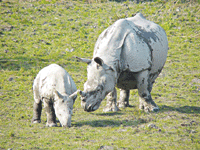 The history of Kaziranga National Park can be traced back to the beginning of the 20th century, before it was formally declared a protected sanctuary on February 11, 1974. Earlier during the 19th century, the area around Kaziranga was notoriously famous for wild animals, malaria, frequent floods and the unpredictable course of the mighty River Brahmaputra. With the rise of the tea industry in Assam, the forests of the area were gradually cleared for settlement and plantations.
The history of Kaziranga National Park can be traced back to the beginning of the 20th century, before it was formally declared a protected sanctuary on February 11, 1974. Earlier during the 19th century, the area around Kaziranga was notoriously famous for wild animals, malaria, frequent floods and the unpredictable course of the mighty River Brahmaputra. With the rise of the tea industry in Assam, the forests of the area were gradually cleared for settlement and plantations.
Conservation efforts in Kaziranga began soon after a visit of Lady Curzon, the American first wife of Lord Curzon, Viceroy of India in 1904. Concerned about the dwindling rhinos, Lord Curzon took action to save the endangered beast. Thus the 57,273 acre Kaziranga Proposed Reserve Forest was cleared on June 1, 1905. Subsequently the boundaries of the Park were extended several times in 1913, 1917 and lastly in 1967 towards the south to provide a corridor to the animals to cross over to the Karbi Anglong Hills, when the Brahmaputra is in spate.
Manas Wildlife Sanctuary
The north-eastern state of Assam (pop.26.65 million) also boasts the Manas Wildlife Sanctuary, given World Heritage Site status in 1985, to protect it from rampant poaching and terrorist activity. This rugged national park in the Himalayan foothills extends across the borders of Bhutan and is alive with rare and endangered wildlife and game including the Assam Roofed Turtle, Hispid Hare, Golden Langur and Pygmy Hog. The park is named after the Manas River, a major tributary of the Brahma-putra which flows through the park.
Situated in the Eastern Himalayan foothills, Manas Natural Park is densely forested, with six rivers including the Manas, flowing through the sanctuary. The weather is salubrious throughout the year.
Sundarbans National Park
The gem among the country’s national parks, encompassing two countries (India and Bangladesh), the Sundarbans are spread over 10,000 sq. km of land and water in the Ganges delta of eastern India. Untamed, natural, and real, the park contains the world’s largest mangrove swamps and hosts the lordly and endangered striped beast — the Royal Bengal Tiger. Indeed the Sundarbans delta of West Bengal, is one of the largest reserves of the Bengal Tiger.
The history of preservation and wildlife in the area can be traced back to 200-300 AD when a city was built by Chand Sadagar, a Bengali ruler. Later during the Mughal era, Raja Basand Rai and his nephew took refuge in the Sundarbans to escape the advancing armies of Emperor Akbar. Many of the palaces and other buildings built by them later fell into the hands of Portuguese pirates, salt smugglers and dacoits in the 17th century.
 During the period (1203-1538), local kings leased out the forests of the Sundarbans. Later in 1757 the British East India Company obtained proprietary rights over the forest from the Mughal Emperor Alamgir II and mapped the entire area in 1764. In 1875-76, the Sundarbans was declared a reserved forest.
During the period (1203-1538), local kings leased out the forests of the Sundarbans. Later in 1757 the British East India Company obtained proprietary rights over the forest from the Mughal Emperor Alamgir II and mapped the entire area in 1764. In 1875-76, the Sundarbans was declared a reserved forest.
Accorded the World Heritage Site status in 1987, the park comprises 54 small islands and is crisscrossed by several distributaries of the Ganga, with 26 mangrove species. Currently there are over 200 Royal Bengal Tigers in the reserve, distinguished for their man-eating tendencies and capability to swim in saline waters .